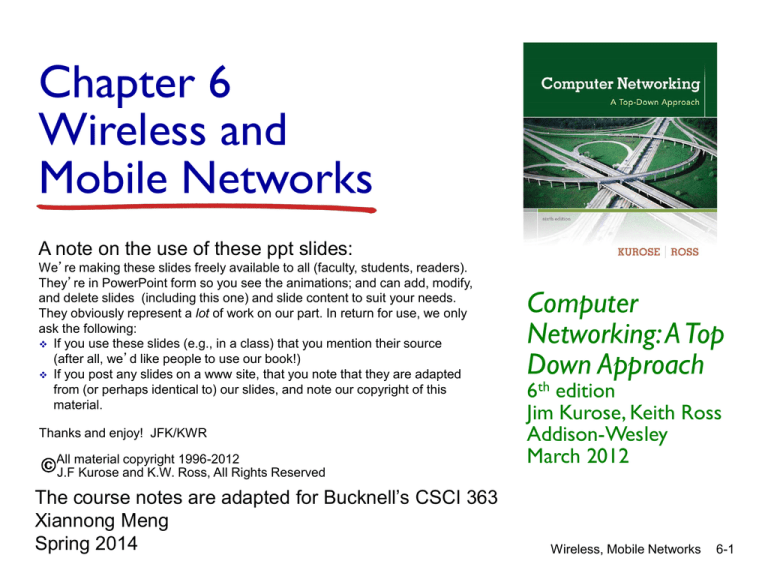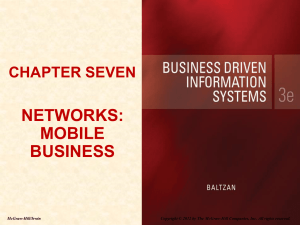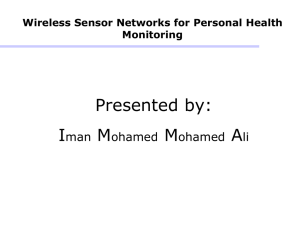
Chapter 6
Wireless and
Mobile Networks
A note on the use of these ppt slides:
We’re making these slides freely available to all (faculty, students, readers).
They’re in PowerPoint form so you see the animations; and can add, modify,
and delete slides (including this one) and slide content to suit your needs.
They obviously represent a lot of work on our part. In return for use, we only
ask the following:
If you use these slides (e.g., in a class) that you mention their source
(after all, we’d like people to use our book!)
If you post any slides on a www site, that you note that they are adapted
from (or perhaps identical to) our slides, and note our copyright of this
material.
Thanks and enjoy! JFK/KWR
All material copyright 1996-2012
J.F Kurose and K.W. Ross, All Rights Reserved
The course notes are adapted for Bucknell’s CSCI 363
Xiannong Meng
Spring 2014
Computer
Networking: A Top
Down Approach
6th edition
Jim Kurose, Keith Ross
Addison-Wesley
March 2012
Wireless, Mobile Networks
6-1
Ch. 6: Wireless and Mobile Networks
Background:
Number of wireless (mobile) phone subscribers now
exceeds number wired phone subscribers (5-to-1)!
World has about 6 billion cell phone subscribers (2011
statistics) (http://www.huffingtonpost.com/2012/10/11/cellphones-world-subscribers-six-billion_n_1957173.html)
China has about 1.2 billion mobile phones, India 1.1 billions,
U.S. 327 millions (2013 statistics)
(http://en.wikipedia.org/wiki/List_of_countries_by_number_o
f_mobile_phones_in_use)
Though not all are digital/network ready, they potentially will be.
Wireless, Mobile Networks
6-2
Ch. 6: Wireless and Mobile Networks
Background:
# wireless Internet-connected devices equals
# wireline Internet-connected devices
laptops, Internet-enabled phones promise anytime
untethered Internet access
two important (but different) challenges
wireless: communication over wireless link
mobility: handling the mobile user who changes
point of attachment to network
Wireless, Mobile Networks
6-3
Chapter 6 outline
6.1 Introduction
Mobility
Wireless
6.5 Principles: addressing and
routing to mobile users
6.6 Mobile IP
6.7 Handling mobility in
cellular networks
6.8 Mobility and higher-layer
protocols
6.2 Wireless links,
characteristics
CDMA
6.3 IEEE 802.11 wireless
LANs (“Wi-Fi”)
6.4 Cellular Internet Access
architecture
standards (e.g., GSM, 4G
LTE)
6.9 Summary
Wireless, Mobile Networks
6-4
Elements of a wireless network
network
infrastructure
Wireless, Mobile Networks
6-5
Elements of a wireless network
wireless hosts
network
infrastructure
laptop, smartphone
run applications
may be stationary (nonmobile) or mobile
wireless does not always
mean mobility
Wireless, Mobile Networks
6-6
Elements of a wireless network
base station
network
infrastructure
typically connected to
wired network
relay - responsible for
sending packets between
wired network and
wireless host(s) in its
“area”
e.g., cell towers,
802.11 access points
Wireless, Mobile Networks
6-7
Elements of a wireless network
wireless link
network
infrastructure
typically used to connect
mobile(s) to base station
also used as backbone
link
multiple access protocol
coordinates link access
various data rates,
transmission distance
Wireless, Mobile Networks
6-8
Characteristics of selected wireless links
Data rate (Mbps)
200
54
5-11
802.11n
802.11a,g
802.11b
4
1
802.11a,g point-to-point
4G: LTE WIMAX
3G: UMTS/WCDMA-HSPDA, CDMA2000-1xEVDO
802.15
.384
2.5G: UMTS/WCDMA, CDMA2000
.056
2G: IS-95, CDMA, GSM
Indoor
Outdoor
10-30m
50-200m
Mid-range
outdoor
Long-range
outdoor
200m – 4 Km
5Km – 20 Km
Wireless, Mobile Networks
6-9
Acronym in wireless communication
4G LTE: 4th Generation Long Term Evolution
UMTS: Universal Mobile Telecommunications
802.11a,g point-to-point
System
4G: LTE WIMAX
HSPDA: High-Speed
Downlink CDMA2000-1xEVDO
Packet Access
3G: UMTS/WCDMA-HSPDA,
802.15 Enhanced Voice-Data Optimized
EVDO:
GSM: Global System for Mobile Communications
2G: IS-95, CDMA, GSM
Wireless, Mobile Networks 6-10
Elements of a wireless network
infrastructure mode
network
infrastructure
base station connects
mobiles into wired
network
handoff: mobile changes
base station providing
connection into wired
network
Wireless, Mobile Networks 6-11
Elements of a wireless network
ad hoc mode
no base stations
nodes can only
transmit to other
nodes within link
coverage
nodes organize
themselves into a
network: route
among themselves
Wireless, Mobile Networks 6-12
Wireless network taxonomy
single hop
infrastructure
(e.g., APs)
no
infrastructure
host connects to
base station (WiFi,
WiMAX, cellular)
which connects to
larger Internet
no base station, no
connection to larger
Internet (Bluetooth,
ad hoc nets)
multiple hops
host may have to
relay through several
wireless nodes to
connect to larger
Internet: mesh net
no base station, no
connection to larger
Internet. May have to
relay to reach other
a given wireless node
MANET,VANET
Wireless, Mobile Networks 6-13
Chapter 6 outline
6.1 Introduction
Mobility
Wireless
6.5 Principles: addressing and
routing to mobile users
6.6 Mobile IP
6.7 Handling mobility in
cellular networks
6.8 Mobility and higher-layer
protocols
6.2 Wireless links,
characteristics
CDMA
6.3 IEEE 802.11 wireless
LANs (“Wi-Fi”)
6.4 Cellular Internet Access
architecture
standards (e.g., GSM)
6.9 Summary
Wireless, Mobile Networks 6-14
Wireless Link Characteristics (1)
important differences from wired link ….
decreased signal strength: radio signal attenuates as it
propagates through matter (path loss)
interference from other sources: standardized wireless
network frequencies (e.g., 2.4 GHz) shared by other
devices (e.g., phone); devices (motors) interfere as
well
multipath propagation: radio signal reflects off objects
ground, arriving at destination at slightly different
times
…. make communication across (even a point to point)
wireless link much more “difficult”
Wireless, Mobile Networks 6-15
Wireless Link Characteristics (2)
SNR: signal-to-noise ratio
10-1
larger SNR – easier to
extract signal from noise (a
“good thing”)
SNR versus BER tradeoffs
given physical layer: increase
power -> increase SNR>decrease BER
given SNR: choose physical layer
that meets BER requirement,
giving highest thruput
• SNR may change with
mobility: dynamically adapt
physical layer (modulation
technique, rate)
10-3
BER
10-2
10-4
10-5
10-6
10-7
10
20
30
40
SNR(dB)
QAM256 (8 Mbps)
QAM16 (4 Mbps)
BPSK (1 Mbps)
Wireless, Mobile Networks 6-16
Wireless network characteristics
Multiple wireless senders and receivers create additional
problems (beyond multiple access):
B
A
C
C
B
C’s signal
strength
A’s signal
strength
A
Hidden terminal problem
B, A hear each other
B, C hear each other
A, C can not hear each other
means A, C unaware of their
interference at B
space
Signal attenuation:
B, A hear each other
B, C hear each other
A, C can not hear each other
interfering at B
Wireless, Mobile Networks 6-17
Code Division Multiple Access (CDMA)
unique “code” assigned to each user; i.e., code set
partitioning
all users share same frequency, but each user has own
“chipping” sequence (i.e., code) to encode data
allows multiple users to “coexist” and transmit
simultaneously with minimal interference (if codes are
“orthogonal”)
encoded signal = (original data) • (chipping
sequence) (operator • means inner product)
decoding: (encoded signal) • (chipping sequence)
Wireless, Mobile Networks 6-18
CDMA encode/decode
sender
d0 = 1
data
bits
code
Zi,m= di.cm
-1 -1 -1
1
-1
1 1 1
-1 -1 -1
slot 1
-1
slot 1
channel
output
1
-1
1 1 1 1 1 1
1
d1 = -1
1 1 1
channel output Zi,m
-1 -1 -1
slot 0
1
-1
-1 -1 -1
slot 0
channel
output
M
Di = S Zi,m.cm
m=1
received
input
code
receiver
1 1 1 1 1 1
1
-1 -1 -1
-1
1 1 1
1
-1
-1 -1 -1
-1
1 1 1
-1 -1 -1
slot 1
M
1
1
-1
-1 -1 -1
slot 0
d0 = 1
d1 = -1
slot 1
channel
output
slot 0
channel
output
Wireless, Mobile Networks 6-19
CDMA: two-sender interference
Sender 1
channel sums together
transmissions by sender 1
and 2
Sender 2
using same code as
sender 1, receiver recovers
sender 1’s original data
from summed channel
data!
Wireless, Mobile Networks 6-20






